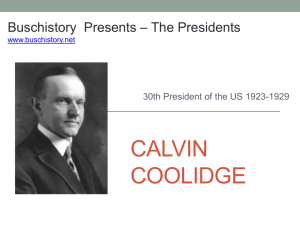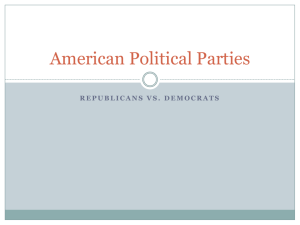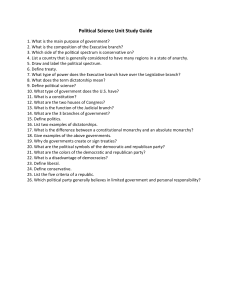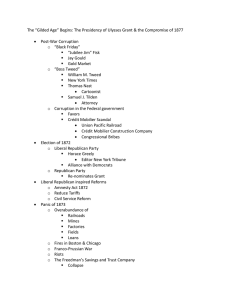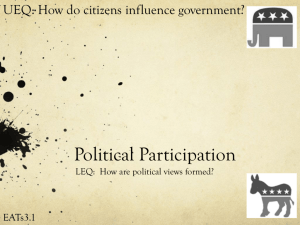Political Parties - Warren Hills Regional School District
advertisement
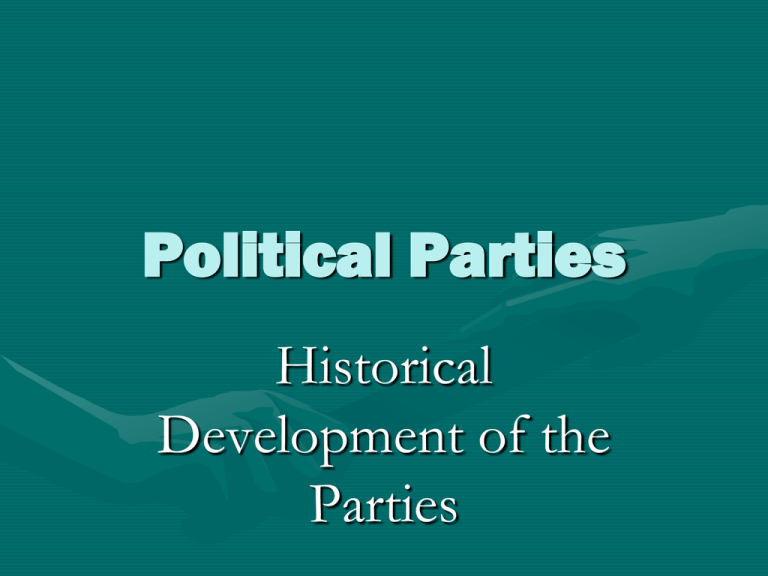
Political Parties Historical Development of the Parties Historical Development • Historically, the two-party system has been characterized by long periods of dominance by one party followed by a long period of dominance by the other Historical Development • The eras begin & end with shifts in the voting population called realignments: • (1) Issues change • (2) New divisions form between groups Early Years • First two political parties to emerge during Washington’s term of office were the Federalists & AntiFederalists Early Years • Major issue in the beginning was the ratification of the Constitution • Federalists supporting it • Anti-Federalists wanting guarantees individual freedoms & rights not included in the original document How was the issue resolved? Early Years • Issue was resolved with the addition of the Bill of Rights, but the parties did not disappear with the issue Federalists • Led by Alexander Hamilton (Secretary of Treasury) • Represented urban, businessoriented men who favored elitism & a strong central government Federalists • Supported Hamilton’s establishment of the Bank of U.S. • Viewed it as forwarding their interests & beliefs Anti-Federalists • Came to be known as the Democratic-Republicans • Led by Thomas Jefferson • Favored strong state governments, rural interests, and a weaker central government Anti-Federalists • Opposed the bank as an enemy of state control & rural interests “Era of Good Feeling” • With Hamilton’s death & John Adams’ unpopularity as president, Jefferson emerged as the most popular leader of the turn of the 19th century “Era of Good Feeling” • As president, he gradually became more accepting of stronger central government • Two parties’ points of view seemed to merge most notably in the “Era of Good Feeling” presided over by James Monroe (one of Jefferson’s protégés) “Era of Good Feeling” • Democratic-Republicans emerged as the only party • Dominance lasted until the mid-1800s, though under a new name, the Democrats Jacksonian Democracy • Two-party system re-emerged with the appearance of Andrew Jackson • Represented to many the expanding country (newer states found much in common with the rural southern states but little with the established northeast) Jacksonian Democracy • New party emerged—the Whigs • Represented many of the interests of the old Federalist party Jacksonian Democracy • Jackson’s election in 1828 was accomplished with a coalition between South & West, forming the new Democratic Party Jacksonian Democracy • Jackson’s Democrats were a rawer sort than Jefferson’s (primarily gentlemen farmers from the South & Middle Atlantic states) Jacksonian Democracy • During the Jacksonian era—universal manhood suffrage was achieved (virtually all men could vote) • Rural, anti-bank, small farmers from the South & West formed the backbone of the Democratic Party Jacksonian Democracy • Whigs were left with: • Old Federalist interests • Wealthy, rural Southerners who had little in common with other Whigs Jacksonian Democracy • Party was not ideologically coherent • Found some success by nominating & electing war heroes (William Henry Harrison, Zachary Taylor) North/South Tensions • Economic & social tensions developed between North & South by the 1840s & 50 • Whig party was threatened by splits between southern & northern wings North/South Tensions • As the Whigs were falling apart, a new Republican Party emerged from the issue of expansion of slavery into new territories North/South Tensions • Election of 1860 brought the first Republican—Abraham Lincoln—into office— • Setoff the secession of southern states & with them many supporters of the Democratic Party North/South Tensions • Civil War ended the dominance of the Democrats & ushered in a new Republican era • Voters realigned—according to regional differences & conflicting points of view regarding expansion of slavery & states rights Republican Era: 1861-1933 • With the exception of Grover Cleveland & Woodrow Wilson, all presidents from Abraham Lincoln (1861-1895) through Herbert Hoover (1929-1933) were Republicans Republican Era: 1861-1933 • During most of the time, Republicans dominated the legislature as well Republican Era: 1861-1933 • By 1875 all of the southern states had been restored to the Union, but their power, as well as that of the Democratic Party, was much diminished Republican Era: 1861-1933 • Republicans came to champion the new era of the Industrial Revolution • Time when prominent businessmen, such as John Rockefeller & Andrew Carnegie, dominated politics as well as business Republican Era: 1861-1933 • Republican party came to represent laissez-faire • Policy that advocated the free market & few government regulations on business Republican Era: 1861-1933 • Republican philosophy of the late 1800s favored the new industrialists, not the small farmer of the earlier era Second Democratic Era: 1933-1969 • Prosperous, business-oriented era survived several earlier recessions but not the Great Depression that gripped the country after the stock market crash of 1929 Second Democratic Era: 1933-1969 • Economic downturn of the economy caused major realignments of voters that swung the balance of power to the Democrats Second Democratic Era: 1933-1969 • Republican president, Herbert Hoover, was rejected in the election of 1932 in favor of the Democrat’s Franklin Roosevelt • FDR’s victory was accomplished because of the “Roosevelt Coalition” of voters FDR’s Coalition • Consisted of a combination of many different groups of voters that wished to see Hoover defeated FDR’s Coalition • • • • • • Composed of: Eastern workers Recent immigrants Southern & western farmers Blacks Ideologically liberal Roosevelt’s Democrats • Established a government more actively involved in promoting social welfare FDR’s Presidency • Ironically, the formerly states rights oriented Democrats now advocated a strong central government, but one dedicated to promoting the interests of ordinary people FDR’s Presidency • Democrats dominated both legislative & executive branches FDR’s Presidency • Even the Supreme Court reined in its conservative leanings • Although it did check FDR’s power with the famous “court packing” threat FDR’s “Court-Packing” Threat • In an effort to get more support for his New Deal programs form the Supreme Court, FDR encouraged Congress to increase the number of justices form 9 to 15 • FDR eventually withdrew his plan Second Democratic Era: 1933-1969 • FDR was elected to unprecedented four terms & was followed by another Democrat, Harry Truman • Even though a Republican, Dwight Eisenhower, was elected president in 1952, Congress remained Democrat Second Democratic Era: 1933-1969 • Democrats regained the White House in 1960 & retained it throughout the presidencies of John F. Kennedy & Lyndon Johnson Era of Divided Government: 19692000 • Richard Nixon’s election in 1968 did not usher in a new era of Republican dominated government • Instead a new balance of power between the Democrats & Republicans came into being Era of Divided Government: 19692000 • With few exceptions, control of the legislature & the presidency has been “divided” between the two major parties since the late 1940s Era of Divided Government: 19692000 • When one party holds the presidency, the other has dominated Congress, or at least the Senate Era of Divided Government: 19692000 • Division brings with it the problem of “gridlock” • Tendency to paralyze decision making, with one branch advocating one policy & the other another contradictory policy Era of Divided Government: 19692000 • Scholars have various theories about the causes of the new division of power • One cause might be the declining power of political parties in general Republican Hold on the Presidency • From 1969 through 1993, and 20002008, the Republicans held the presidency except during: • Carter presidency – 1977-1981 • Clinton presidency – 1993-2001 Republican Hold on the Presidency • Starting in the 1960s, Republicans began to pay more attention to the power of electronic media & to the importance of paid professional consultants Republican Hold on the Presidency • Evolved into a well-financed, efficient organization • Depended heavily on professionals to help locate & promote the best candidate for office Republican Hold on the Presidency • Some experts believe that these changes were largely responsible for Richard Nixon’s victory in 1968 • Nixon was carefully coached & his campaign was carefully managed to take advantage of electronic media Republican Hold on the Presidency • Campaign made extensive use of public opinion polls to determine strategy • New emphasis also influenced party’s choice of candidates in 1980 & 1984 • Former TV & film actor Ronald Reagan was master of the media Republican Hold on the Presidency • Party also took advantage of new technology & generated computerized mailings to raise large sums of money for campaigns • By the mid-1980s, Republicans were raising much more money than the Democrats were Republican Hold on the Presidency • During the same period, Democrats were changing in many opposite ways than the Republicans Republican Hold on the Presidency • Democrats became more concerned with grass roots, or common man representation Republican Hold on the Presidency • Democrats were reacting at least partly to the break-up of the old Roosevelt Coalition, but also to the disastrous 1968 convention in Chicago that showed the party as highly factionalized & lacking leadership Republican Hold on the Presidency • As a result, they gained a reputation as being: • disorganized • disunited Republican Hold on the Presidency • In 1969, the Democratic party appointed a special McGovern-Fraser Commission to review the party’s structure & delegate selection procedures Republican Hold on the Presidency • Commission determined that minorities, women, youth, and the poor were not adequately represented at the party convention Republican Hold on the Presidency • Party adopted guidelines that increased the representation & participation of these groups Republican Hold on the Presidency • Number of super-delegates (governors, members Congress & other party leaders) was reduced substantially Republican Hold on the Presidency • 1972 convention selected as their candidate George McGovern • Liberal who lost a landslide to Republican Richard Nixon Republican Hold on the Presidency • Although Democrat Jimmy Carter won the presidency in 1976, he was defeated by Ronald Reagan in 1980 • Republican Party held the presidency since, with the exception of the Clinton presidency (1992-2000) Republican Hold on the Presidency • During the Reagan presidency, the Democrats began to adopt some of the Republican strategies: • Computerized mailing lists • Opinion polls • Paid consultants Republican Hold on the Presidency • Using newly adopted Republican party strategies, the Democratic party managed to get their candidate, Bill Clinton to the White House in 1993, a position that he held for two terms
